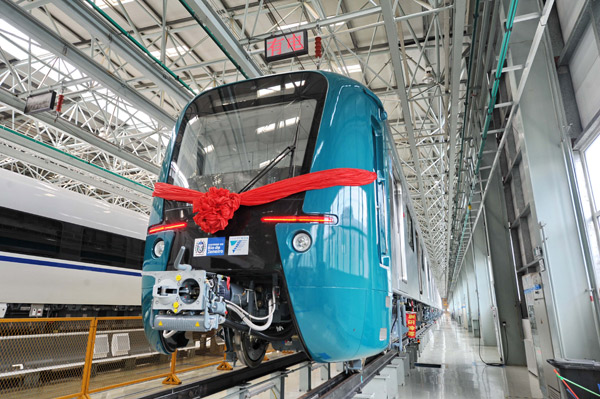Chinese trains on track for Olympics
 |
|
A crane works on a station of metro Line 4 in Rio de Janeiro on Sunday. According to Rodrigo Vieira, state secretary of transportation, 96 percent of the work on the new line has been completed. LI MING FOR CHINA DAILY |
A new subway line linking Rio de Janeiro's city center, tourist neighborhoods and beach areas to the main Olympic zone will start operating on Aug 1, the state government of Rio de Janeiro has confirmed.
The key transport line for the Olympics will use Chinese trains designed and produced by CRRC Changchun Railway Vehicles Co — 100 electric multiple units (EMU), a type of intercity, high-speed subway train from China.
During the games, which begin on Aug 5, services on the new subway route — Line 4 — will run from 6 am to 1 am on work days and Saturdays and from 7 am to 1 am on Sundays and public holidays. Access is limited to people related to the Olympics during the games but the line will be fully open to the public after the games.
Track has now been laid along the entire length of the new line, which begins in the beachside neighborhood of Ipanema and ends in Barra da Tijuca, home of Barra Olympic Park, the heart of games with nine venues hosting 16 Olympic and nine Paralympic sports, along with the main press and international broadcast centers.
At the end of May, an underground train made the first complete journey on line 4 from Ipanema to Barra. Work on the construction project is now more than 96 percent complete; electrical, ventilation and signaling systems are currently undergoing trials and new escalators and moving walkways are being tested.
Changchun plays a key role in these tests as its trains have to mesh with all of the electrical systems. Technicians are also testing engines, breaks, doors and internal partitions of the train. During the games, company staff will be on call 24-7 to guarantee operations go smoothly.
When fully operational, Line 4 will transport up to 300,000 passengers a day and remove about 2,000 vehicles per hour from Rio's roads at peak traffic times.
Rio State Transportation Secretary Rodrigo Vieira told China Daily that local people are satisfied with the quality of Chinese trains.
"The subway trains have been operational in Rio's subway line 1 and 2, and we can say the local people 100 percent accept and welcome the trains. Most of the trains we use on the Olympic subway line are from China," he said.
"Line 4 will contribute to making the Rio de Janeiro Olympic Games the best in history and will become an important legacy for the city, improving the quality of life for the residents," he added.
Changchun Railway Vehicles Co belongs to China CRRC Corp Ltd, one of China's largest train makers. CRRC started to research the Latin American market in 2004. Three years later, when Rio was chosen to host the 2014 World Cup, the government of Rio vowed to improve the city's rail network.
In 2009, when Rio won the bid for the 2016 Summer Olympics, the city signed contracts with CRRC for the China-made vehicles, with CRRC winning out over Siemens and Alstom.
CRRC first got orders for 30 EMUs. After those arrived in Brazil in March 2012, CRRC won orders for another 70 EMUs, thanks to the train's high performance and comfortable interior.
CRRC's participation in the Rio Olympics will mark the first time that a Chinese train maker has taken part in an Olympic transportation system outside of China. To win the contracts, CRRC offered high-tech and cost-efficient solutions and adjustments to meet Rio's special needs.
The state and city of Rio are investing heavily in transportation infrastructure ahead of the games. Last week, Rio's international airport opened a new building that nearly doubles its passenger capacity. The road linking Barra to southern Rio has been expanded, increasing its capacity by 30 per cent. A new light rail system has also begun operating in the city center.




















